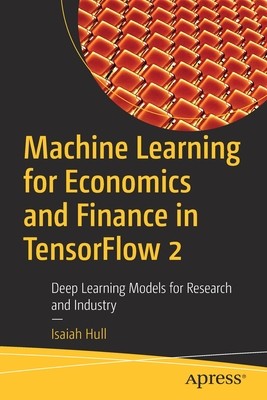
- We will send in 10–14 business days.
- Author: Isaiah Hull
- Publisher: Apress
- ISBN-10: 1484263723
- ISBN-13: 9781484263723
- Format: 15.6 x 23.4 x 2 cm, softcover
- Language: English
- SAVE -10% with code: EXTRA
Machine Learning for Economics and Finance in Tensorflow 2 (e-book) (used book) | bookbook.eu
Reviews
Description
Machine learning has taken time to move into the space of academic economics. This is because empirical research in economics is concentrated on the identification of causal relationships in parsimonious statistical models; whereas machine learning is oriented towards prediction and is generally uninterested in either causality or parsimony. That leaves a gap for students, academics, and professionals who lack a standard reference on machine learning for economics and finance.
This book focuses on economic and financial problems with an empirical dimension, where machine learning methods may offer something of value. This includes coverage of a variety of discriminative deep learning models (DNNs, CNNs, LSTMs, and DQNs), generative machine learning models (GANs and VAEs), and tree-based models. It also covers the intersection of empirical methods in economics and machine learning, including regression analysis, natural language processing, and dimensionality reduction. TensorFlow offers a toolset that can be used to define and solve any graph-based model, including those commonly used in economics. This book is structured to teach through a sequence of complete examples, each framed in terms of a specific economic problem of interest or topic. This simplifies otherwise complicated concepts, enabling the reader to solve workhorse theoretical models in economics and finance using TensorFlow. What You'll Learn- Define, train, and evaluate machine learning models in TensorFlow 2
- Apply fundamental concepts in machine learning, such as deep learning and natural language processing, to economic and financial problems
- Solve theoretical models in economics
Who This Book Is For
Students, data scientists working in economics and finance, public and private sector economists, and academic social scientists
EXTRA 10 % discount with code: EXTRA
The promotion ends in 17d.07:41:35
The discount code is valid when purchasing from 10 €. Discounts do not stack.
- Author: Isaiah Hull
- Publisher: Apress
- ISBN-10: 1484263723
- ISBN-13: 9781484263723
- Format: 15.6 x 23.4 x 2 cm, softcover
- Language: English English
Machine learning has taken time to move into the space of academic economics. This is because empirical research in economics is concentrated on the identification of causal relationships in parsimonious statistical models; whereas machine learning is oriented towards prediction and is generally uninterested in either causality or parsimony. That leaves a gap for students, academics, and professionals who lack a standard reference on machine learning for economics and finance.
This book focuses on economic and financial problems with an empirical dimension, where machine learning methods may offer something of value. This includes coverage of a variety of discriminative deep learning models (DNNs, CNNs, LSTMs, and DQNs), generative machine learning models (GANs and VAEs), and tree-based models. It also covers the intersection of empirical methods in economics and machine learning, including regression analysis, natural language processing, and dimensionality reduction. TensorFlow offers a toolset that can be used to define and solve any graph-based model, including those commonly used in economics. This book is structured to teach through a sequence of complete examples, each framed in terms of a specific economic problem of interest or topic. This simplifies otherwise complicated concepts, enabling the reader to solve workhorse theoretical models in economics and finance using TensorFlow. What You'll Learn- Define, train, and evaluate machine learning models in TensorFlow 2
- Apply fundamental concepts in machine learning, such as deep learning and natural language processing, to economic and financial problems
- Solve theoretical models in economics
Who This Book Is For
Students, data scientists working in economics and finance, public and private sector economists, and academic social scientists


Reviews